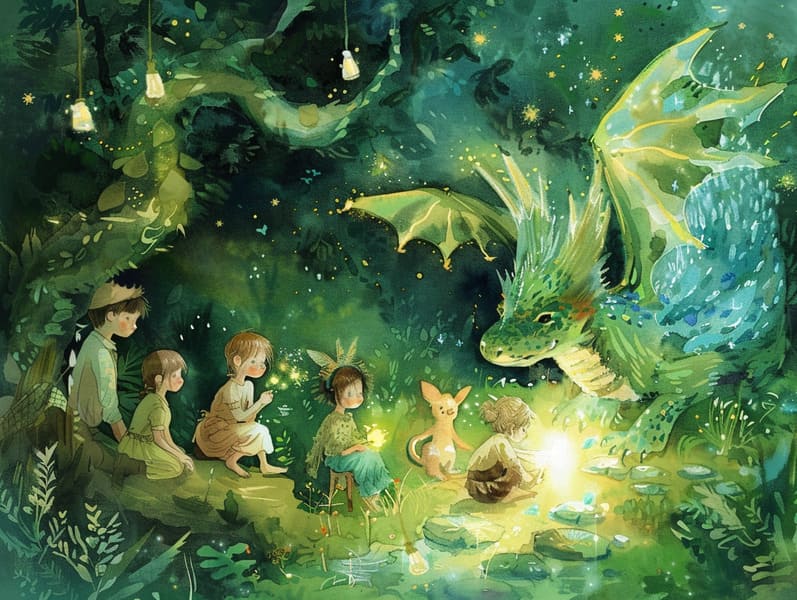The Rise of Best Fairy Tales and the Invariable Mystique.
The Rise of Best Fairy Tales and the Invariable Mystique.
Blog Article

Historical fairy tales have historical significance. These narratives have been shared from one generation to the next far before they were ever transcribed. They were born from a variety of backgrounds, including Middle Eastern traditions. They were initially disseminated among elders, often carrying themes and messages related to the societal norms and beliefs of the time.
The renowned Brothers Grimm, Jacob and Wilhelm (the Grimm brothers), were among the first to collect and release many of these beloved fairy tales. Their volume, "Grimm's Folk Tales," included stories like "Ashenputtel," "Hansel and Grethel," and "Schneewittchen," which have since become pillars in the world of beloved fairy tales. Similarly, Andersen's magical narratives, such as "The Sea Maid," and "The Story of the Ugly Duckling," have won hearts worldwide, ensuring their place in the pantheon of treasured fairy tales.
Though they are centuries old, classic fairy tales remain as significant as ever, especially as kids' bedtime tales. These enchanting tales are now available in many formats, including vibrantly illustrated books, enchanting animations, and online storybooks.
Their persistent charm can be ascribed to several fascinating points:
Valuable Lessons: Timeless fairy tales often teach important moral lessons. Fairy tales like "The Story of the Boy Who Cried Wolf" teach the value of integrity, while "The Race of the Tortoise and the Hare" show the virtues of persistence and modesty. These tales offer little ones clear distinctions between correct and incorrect, molding their moral compass in a subtle yet important way.
Sympathy and Perception: Ancient fairy tales frequently include heroines facing challenges and problems, prompting listeners to relate with their struggles and back their triumphs. For instance, "Beauty's Beast" shows us the merit of seeing inner beauty to comprehend the true being of a person, fostering tenderness and perception.
Cultural Awareness: Many timeless fairy tales are deeply embedded in the cultural contexts from which they bloomed. Reading these narratives can provide delightful insights into different ways of life, strengthening a sense of global appreciation and acknowledgment.
Creativity and Fantasy: The fanciful elements in fairy tales—enchanted forests—engender children’s fantasies. These stories lead readers to otherworldly realms, activating innovative ideas and a sense of enchantment that lasts a lifetime.
Ancient fairy tales are not only captivating but also instructive. They provide captivating tools in building various brain and heart skills in children. When ancient fairy tales are narrated, they enhance language acquisition by bringing new language items and sophisticated sentence structures. This practice also strengthens auditory perception and mental focus, as little ones track the narrative, anxious to see what happens next.
Furthermore, examining the themes and characters of old fairy tales can strengthen cognitive skills and problem-solving abilities. Young readers learn to find patterns, anticipate outcomes, and get cause and effect. These contemplations also further the young voice their thoughts and feelings, strengthening their emotional intelligence.
In today’s high-tech era, the presence of digital storybooks has made these stories more available than ever. Online resources and apps feature huge assortments of bedtime fairy tales that can be experienced or heard anytime, anywhere. Fairy tales voiced are particularly favored, sharing an interactive way for little ones to engage with these fascinating tales. Spoken stories and read-aloud videos guide characters and settings to life, often accompanied by mesmerizing sound effects and background music that amplify the tale-telling adventure.
The timeless allure of traditional fairy tales lies here in their ability to modify to present eras while sustaining their basic principles. Contemporary updates of these fairy tales often bring in more different protagonists and modern settings, making them relatable to today’s audience. However, the fundamental themes of fearlessness, sympathy, and rightness remain unchanged, continuing to resonate with readers of all ages.
Classic fairy tales also offer a sense of reassurance and comprehensibility. They grant a organized narrative with a evident beginning, middle, and end, often concluding with the wrap-up of conflicts and the triumph of good over bad. This assuredness can be consoling for young readers, yielding a sense of solidity in an always shifting world.
Ancient fairy tales continue to enchant and guide new generations, maintaining their allure and value in modern society. As kids' bedtime tales, they impart upon a perfect blend of charm and enlightenment, nourishing moral values, empathy, and creativity. The proliferation of digital storybooks and the popularity of fairy tales voiced confirm that these old narratives remain acquirable to new generations.
By keeping and conveying these tales, we continue to recognize the rich tapestry of lore and cultural heritage. Whether you are enjoying a vividly illustrated book, viewing a cyber collection, or hearing an spoken story, the attraction of ancient fairy tales is always within reach. These narratives demonstrate of the unending ability of stories and its ability to bond us across centuries and lands.
Even if you are seeing a vibrantly illustrated book, discovering a web collection, or playing an narrated book, the allure of old fairy tales is always within reach.
These tales remind us of the undying force of narratives and its ability to draw us together across epochs and places, weaving a spell that charms and informs alike.